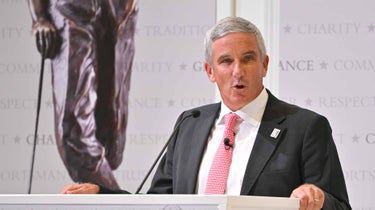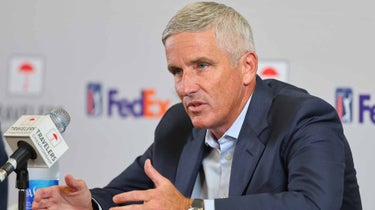
Max Homa hits a tee shot on Thursday at East Lake Golf Club.
Getty Images
Over the past week, if you’re a fan of the men’s pro golf game, you’ve no doubt been trying to wrap your headcover around all of the changes coming to the established brand. It may be complicated, or dizzying, or all of the above. Consider:
There are “top players” now.
And these top players are determined by a program, which has been adjusted from last year, when it debuted.
And the top players gain entry into 12 “elevated events.” And the top players will play 20 times.
And everyone gets paid now. And everyone gets travel money.
Oh, and they’re going to play Monday Night Golf. In an arena.
And all of this is to beat back the upstart.
Got that?
Thankfully, there’s Max Homa. Homa, you may know, is golf’s Twitter king, though he’s more than a pair of thumbs on a cellphone. He’s among the 30 at this week’s Tour Championship, and during Friday’s second round, he bettered everybody, shooting a nine-under 62 to go into the weekend in this staggered-start format 10 back of leader Scottie Scheffler. And most notably for our exercise here, he’s as sincere as they come. While he won’t get into all of the technicalities, per se, we can at least get candidness.
So we’ll start at the top. What’s he make of the changes to the Player Impact Program, the aforementioned device that will determine the PGA Tour’s top 20? To offer more detail, in its inaugural run a year ago, and through various metrics, the PIP acted as a way to ‘reward’ players who moved the needle only through a cash payout; starting next year, it’ll still reward, though now, along with the money, the PIP is a gateway to big events and their big money.
Help us, Max.
“Yeah, I think the Tour is doing their best to be creative and provide like a different stream of income to the 20 guys now who are driving the revenue for the Tour,” he said Friday during his post-round press conference. “Part of it’s silly, in my opinion, but also part of it’s not.”
How come?
“It makes a ton of sense if someone is out here and there’s the reason — I always use this example. I tied Tiger Woods two years ago, three years ago at Torrey Pines, and I realize we got paid the exact same amount of money and I provided zero dollars to that event and he provided I can’t even come up with a number. So you would think, man, Tiger should get a bit more.
“So I like what they’re doing with that. It’s a tricky thing. It’s like — it’s ambiguous, but the Tour is just trying to make the Tour better and benefit the guys who are helping drive everything for the rest of us. So I think that’s good.”
There’s honesty there. Here’s more. A reporter asked this: “Do you think you’re a generally aware player? Do you think people are generally aware of you?”
“I will say this: I would win this PIP if it was about who gets yelled at in the weirdest ways possible,” he said. “I could be Tiger, I think.”
You can laugh here, if you like. Homa continued.
“I don’t know, people seem more and more aware. I am aware myself that I’m getting a bit more popular, but I don’t know. It would be cool for the money if I could be in the top 20, but I have always wanted to grow the game of golf whether I got paid for it or not. I love this game. I would love more kids to get involved. I’d like it to be more diversified.
“I think the game is in a good place, and I hope to be a part of just making it continue to go that way. I’m just going to try to use my PGA Tour status as kind of the catalyst for that.”
Then there’s the schedule business. This week’s changes expanded on those made in June, and everything was done with an eye on LIV Golf, the controversial, Saudi-backed series that’s already played three 54-hole, 42-player, no-cut, big-purse events, is promising to play more next year, and has been signing some of golf’s biggest names for months.
Now, the PGA Tour will have bigger purses. And while the idea of smaller fields was not talked about much during this week’s changes, you’d figure it’s at least on the table for the future; playoff events next year won’t have a cut, and in the June announcement, there was talk of holding three limited-field and no-cut events next fall.
Help us, Max. A reporter asked him this: “Going forward what do you see as the difference or the difference in value between a limited-field … versus a fuller field?”
“Yeah, I don’t know,” he said. “That’s a really good question, because I think last week is 70, but it’s the 70 best players of the year, right, so it’s a limited field, obviously. I felt like it was really good competition. I don’t just mean at the top. I just felt like the average score was really good. Obviously you add 70 more amazing golfers and it would probably get more competitive. I don’t know if it takes away too much. I actually think it might build some because …”
“More would build some, if there were more?” a reporter asked.
“No, I think it’s possible that less could keep it like very similar and maybe build more of the — we are an entertainment product, so it really isn’t about like the perfect amount of competition, and I don’t know what that number is,” Homa said. “Like I was talking to Xander [Schauffele] about this. I said, I don’t care how good you are at golf; I don’t care how good I am at golf; if people aren’t watching, we’re just telling people in a bar we’re really good at golf.
“It’s like at some point it is about the product and what makes people want to watch us play, and there has always been 144 people or so playing the golf tournaments, but I don’t know if that’s the perfect amount of competition. That’s one you’d need to ask somebody who works on an Excel spreadsheet or something, not me. But I thought last week was a pretty cool testament that we had 70 of the best guys of the season. It was a really exciting tournament at the top, and I felt like even the middle, where I kind of ended up, right in the middle of the top third, it still felt like a fight to pass people because you’re playing against some guys that are playing really good golf.”
“Going forward do you think it’s important for a tournament to have a cut no matter what the size is?” a reporter asked.
“I definitely think it’s something to think about,” Homa said. “I don’t know. We’re selling a golf tournament to a sponsor or to a city. This one is a big city. Atlanta is an amazing city. You want to know that Rory McIlroy is going to be here on Sunday. Unfortunately we had a guy, Tiger, that made that just seem like it was way too easy to guarantee.
“I think for the entertainment it would be good, but I do think that my favorite stat in sports is 142 cuts made in a row [set by Woods]. I think it may be — missing that would be tough, but I also don’t think anyone is going to get anywhere close to it, so maybe we could just check that one off.”
If you’re thinking it’s notable that golf is watching its ratings, you’re right. You can blame the newfound competition there, but it’s both deeper and less complex than that, of course. LIV is simply another entertainment option among countless others, and smart business tells you here to least evaluate your product.
We’ll end things with this exchange. A reporter noted that they thought this all started with TV.
“I think just since television got popular and so prevalent,” Homa said. “That’s a good question, too. But I would say last 20 years since Tiger came along, 30 years since Tiger came along and golf has become so much more popular. It’s become like just — there are common fans of golf. I think probably before it was some sickos and now we still have those and now we have common fans, so making sure it’s really interesting because there’s a lot going on. There’s TikTok, Twitter, Instagram. There’s a lot of little ways to watch spurts of things. We need to keep it interesting for kind of the grand scheme of golf.”
“Do you have the common guys or the sickos? Who follows you?” a reporter asked.
“Oh, man, I don’t know,” Homa said. “That’s a great question. I’d rather not think about that.”














